Leadership Management Assignment: Equality, Grievances and Incentives
VerifiedAdded on 2022/12/29
|11
|3089
|51
Homework Assignment
AI Summary
This assignment delves into key aspects of leadership and management, beginning with a critical analysis of the Equality Act 2010, exploring both direct and indirect discrimination with examples. It then examines the limitations of equal opportunities policies in enhancing workplace diversity. The assignment further explores the concept of grievances, defining them, discussing their causes within organizations, and evaluating the consequences of unresolved grievances. It also describes and analyzes incentive reward systems, examining their connection to market trends. Finally, it discusses the reasons for financial participation in organizations and analyzes pluralism and unitarism approaches, recommending one based on the chosen organization's context. The assignment covers topics such as the Equality Act 2010, direct and indirect discrimination, grievances, incentive systems, financial participation, and organizational approaches. References are provided to support the arguments and analyses presented throughout the assignment.

Online Exam
Paraphrase This Document
Need a fresh take? Get an instant paraphrase of this document with our AI Paraphraser
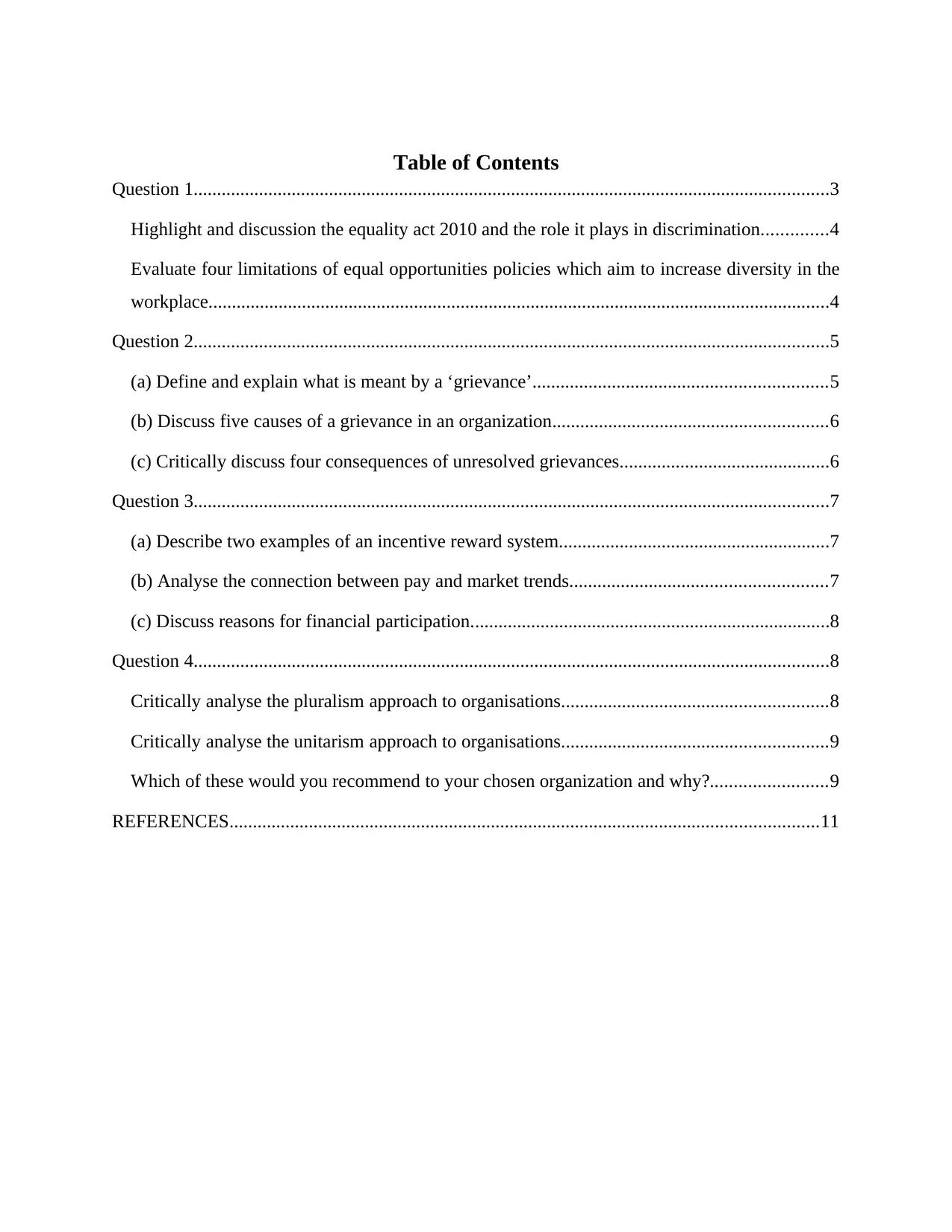
Table of Contents
Question 1........................................................................................................................................3
Highlight and discussion the equality act 2010 and the role it plays in discrimination..............4
Evaluate four limitations of equal opportunities policies which aim to increase diversity in the
workplace.....................................................................................................................................4
Question 2........................................................................................................................................5
(a) Define and explain what is meant by a ‘grievance’...............................................................5
(b) Discuss five causes of a grievance in an organization...........................................................6
(c) Critically discuss four consequences of unresolved grievances.............................................6
Question 3........................................................................................................................................7
(a) Describe two examples of an incentive reward system..........................................................7
(b) Analyse the connection between pay and market trends.......................................................7
(c) Discuss reasons for financial participation.............................................................................8
Question 4........................................................................................................................................8
Critically analyse the pluralism approach to organisations.........................................................8
Critically analyse the unitarism approach to organisations.........................................................9
Which of these would you recommend to your chosen organization and why?.........................9
REFERENCES..............................................................................................................................11
Question 1........................................................................................................................................3
Highlight and discussion the equality act 2010 and the role it plays in discrimination..............4
Evaluate four limitations of equal opportunities policies which aim to increase diversity in the
workplace.....................................................................................................................................4
Question 2........................................................................................................................................5
(a) Define and explain what is meant by a ‘grievance’...............................................................5
(b) Discuss five causes of a grievance in an organization...........................................................6
(c) Critically discuss four consequences of unresolved grievances.............................................6
Question 3........................................................................................................................................7
(a) Describe two examples of an incentive reward system..........................................................7
(b) Analyse the connection between pay and market trends.......................................................7
(c) Discuss reasons for financial participation.............................................................................8
Question 4........................................................................................................................................8
Critically analyse the pluralism approach to organisations.........................................................8
Critically analyse the unitarism approach to organisations.........................................................9
Which of these would you recommend to your chosen organization and why?.........................9
REFERENCES..............................................................................................................................11
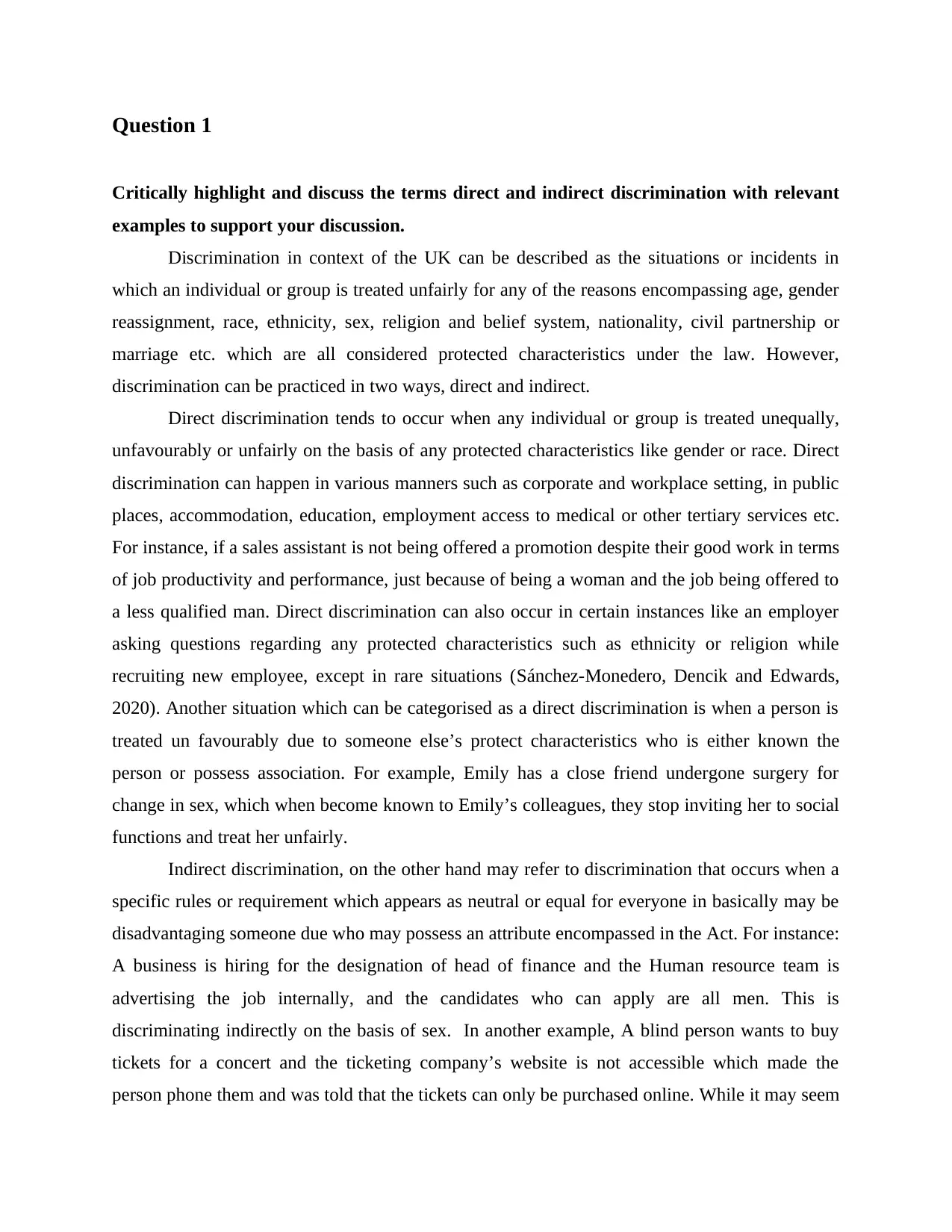
Question 1
Critically highlight and discuss the terms direct and indirect discrimination with relevant
examples to support your discussion.
Discrimination in context of the UK can be described as the situations or incidents in
which an individual or group is treated unfairly for any of the reasons encompassing age, gender
reassignment, race, ethnicity, sex, religion and belief system, nationality, civil partnership or
marriage etc. which are all considered protected characteristics under the law. However,
discrimination can be practiced in two ways, direct and indirect.
Direct discrimination tends to occur when any individual or group is treated unequally,
unfavourably or unfairly on the basis of any protected characteristics like gender or race. Direct
discrimination can happen in various manners such as corporate and workplace setting, in public
places, accommodation, education, employment access to medical or other tertiary services etc.
For instance, if a sales assistant is not being offered a promotion despite their good work in terms
of job productivity and performance, just because of being a woman and the job being offered to
a less qualified man. Direct discrimination can also occur in certain instances like an employer
asking questions regarding any protected characteristics such as ethnicity or religion while
recruiting new employee, except in rare situations (Sánchez-Monedero, Dencik and Edwards,
2020). Another situation which can be categorised as a direct discrimination is when a person is
treated un favourably due to someone else’s protect characteristics who is either known the
person or possess association. For example, Emily has a close friend undergone surgery for
change in sex, which when become known to Emily’s colleagues, they stop inviting her to social
functions and treat her unfairly.
Indirect discrimination, on the other hand may refer to discrimination that occurs when a
specific rules or requirement which appears as neutral or equal for everyone in basically may be
disadvantaging someone due who may possess an attribute encompassed in the Act. For instance:
A business is hiring for the designation of head of finance and the Human resource team is
advertising the job internally, and the candidates who can apply are all men. This is
discriminating indirectly on the basis of sex. In another example, A blind person wants to buy
tickets for a concert and the ticketing company’s website is not accessible which made the
person phone them and was told that the tickets can only be purchased online. While it may seem
Critically highlight and discuss the terms direct and indirect discrimination with relevant
examples to support your discussion.
Discrimination in context of the UK can be described as the situations or incidents in
which an individual or group is treated unfairly for any of the reasons encompassing age, gender
reassignment, race, ethnicity, sex, religion and belief system, nationality, civil partnership or
marriage etc. which are all considered protected characteristics under the law. However,
discrimination can be practiced in two ways, direct and indirect.
Direct discrimination tends to occur when any individual or group is treated unequally,
unfavourably or unfairly on the basis of any protected characteristics like gender or race. Direct
discrimination can happen in various manners such as corporate and workplace setting, in public
places, accommodation, education, employment access to medical or other tertiary services etc.
For instance, if a sales assistant is not being offered a promotion despite their good work in terms
of job productivity and performance, just because of being a woman and the job being offered to
a less qualified man. Direct discrimination can also occur in certain instances like an employer
asking questions regarding any protected characteristics such as ethnicity or religion while
recruiting new employee, except in rare situations (Sánchez-Monedero, Dencik and Edwards,
2020). Another situation which can be categorised as a direct discrimination is when a person is
treated un favourably due to someone else’s protect characteristics who is either known the
person or possess association. For example, Emily has a close friend undergone surgery for
change in sex, which when become known to Emily’s colleagues, they stop inviting her to social
functions and treat her unfairly.
Indirect discrimination, on the other hand may refer to discrimination that occurs when a
specific rules or requirement which appears as neutral or equal for everyone in basically may be
disadvantaging someone due who may possess an attribute encompassed in the Act. For instance:
A business is hiring for the designation of head of finance and the Human resource team is
advertising the job internally, and the candidates who can apply are all men. This is
discriminating indirectly on the basis of sex. In another example, A blind person wants to buy
tickets for a concert and the ticketing company’s website is not accessible which made the
person phone them and was told that the tickets can only be purchased online. While it may seem
⊘ This is a preview!⊘
Do you want full access?
Subscribe today to unlock all pages.

Trusted by 1+ million students worldwide
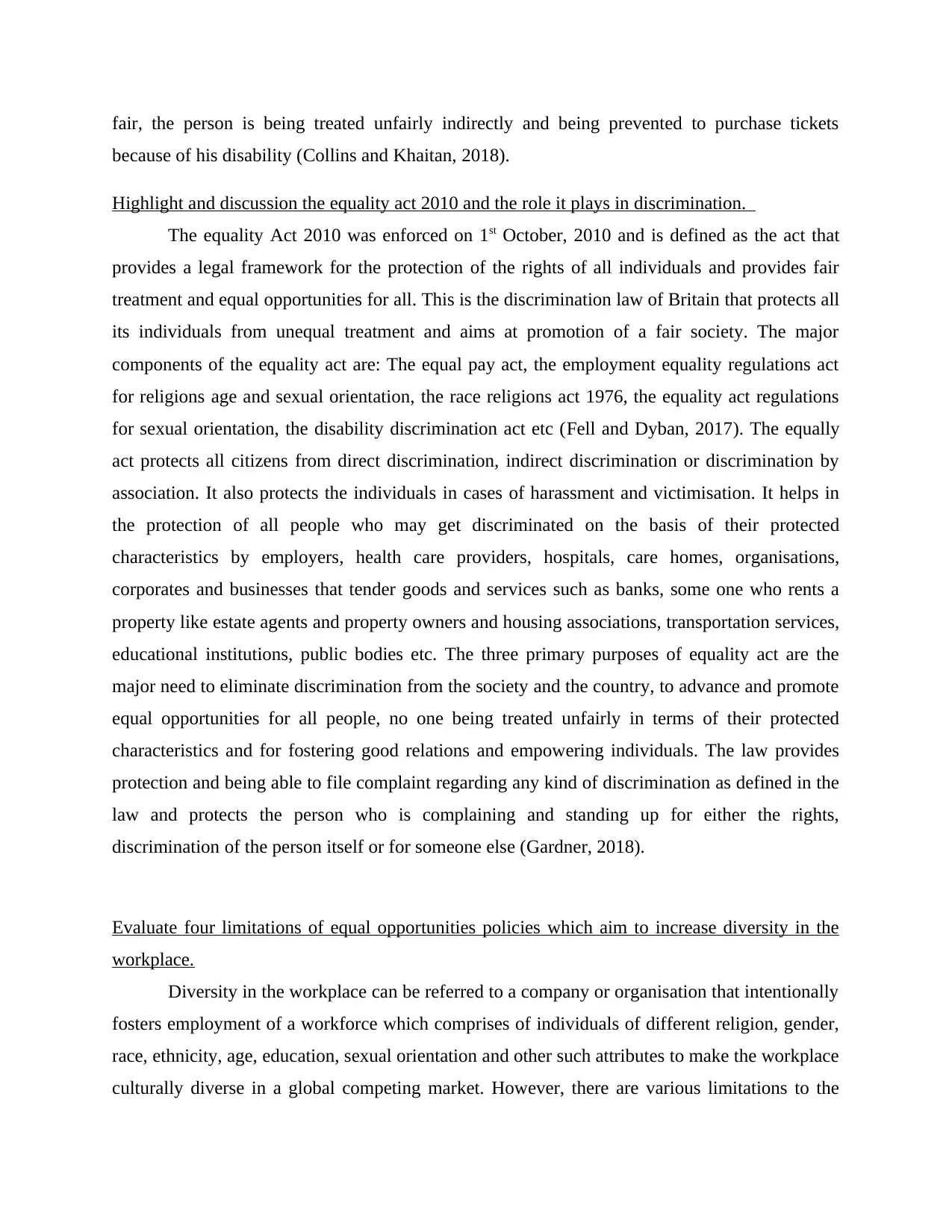
fair, the person is being treated unfairly indirectly and being prevented to purchase tickets
because of his disability (Collins and Khaitan, 2018).
Highlight and discussion the equality act 2010 and the role it plays in discrimination.
The equality Act 2010 was enforced on 1st October, 2010 and is defined as the act that
provides a legal framework for the protection of the rights of all individuals and provides fair
treatment and equal opportunities for all. This is the discrimination law of Britain that protects all
its individuals from unequal treatment and aims at promotion of a fair society. The major
components of the equality act are: The equal pay act, the employment equality regulations act
for religions age and sexual orientation, the race religions act 1976, the equality act regulations
for sexual orientation, the disability discrimination act etc (Fell and Dyban, 2017). The equally
act protects all citizens from direct discrimination, indirect discrimination or discrimination by
association. It also protects the individuals in cases of harassment and victimisation. It helps in
the protection of all people who may get discriminated on the basis of their protected
characteristics by employers, health care providers, hospitals, care homes, organisations,
corporates and businesses that tender goods and services such as banks, some one who rents a
property like estate agents and property owners and housing associations, transportation services,
educational institutions, public bodies etc. The three primary purposes of equality act are the
major need to eliminate discrimination from the society and the country, to advance and promote
equal opportunities for all people, no one being treated unfairly in terms of their protected
characteristics and for fostering good relations and empowering individuals. The law provides
protection and being able to file complaint regarding any kind of discrimination as defined in the
law and protects the person who is complaining and standing up for either the rights,
discrimination of the person itself or for someone else (Gardner, 2018).
Evaluate four limitations of equal opportunities policies which aim to increase diversity in the
workplace.
Diversity in the workplace can be referred to a company or organisation that intentionally
fosters employment of a workforce which comprises of individuals of different religion, gender,
race, ethnicity, age, education, sexual orientation and other such attributes to make the workplace
culturally diverse in a global competing market. However, there are various limitations to the
because of his disability (Collins and Khaitan, 2018).
Highlight and discussion the equality act 2010 and the role it plays in discrimination.
The equality Act 2010 was enforced on 1st October, 2010 and is defined as the act that
provides a legal framework for the protection of the rights of all individuals and provides fair
treatment and equal opportunities for all. This is the discrimination law of Britain that protects all
its individuals from unequal treatment and aims at promotion of a fair society. The major
components of the equality act are: The equal pay act, the employment equality regulations act
for religions age and sexual orientation, the race religions act 1976, the equality act regulations
for sexual orientation, the disability discrimination act etc (Fell and Dyban, 2017). The equally
act protects all citizens from direct discrimination, indirect discrimination or discrimination by
association. It also protects the individuals in cases of harassment and victimisation. It helps in
the protection of all people who may get discriminated on the basis of their protected
characteristics by employers, health care providers, hospitals, care homes, organisations,
corporates and businesses that tender goods and services such as banks, some one who rents a
property like estate agents and property owners and housing associations, transportation services,
educational institutions, public bodies etc. The three primary purposes of equality act are the
major need to eliminate discrimination from the society and the country, to advance and promote
equal opportunities for all people, no one being treated unfairly in terms of their protected
characteristics and for fostering good relations and empowering individuals. The law provides
protection and being able to file complaint regarding any kind of discrimination as defined in the
law and protects the person who is complaining and standing up for either the rights,
discrimination of the person itself or for someone else (Gardner, 2018).
Evaluate four limitations of equal opportunities policies which aim to increase diversity in the
workplace.
Diversity in the workplace can be referred to a company or organisation that intentionally
fosters employment of a workforce which comprises of individuals of different religion, gender,
race, ethnicity, age, education, sexual orientation and other such attributes to make the workplace
culturally diverse in a global competing market. However, there are various limitations to the
Paraphrase This Document
Need a fresh take? Get an instant paraphrase of this document with our AI Paraphraser
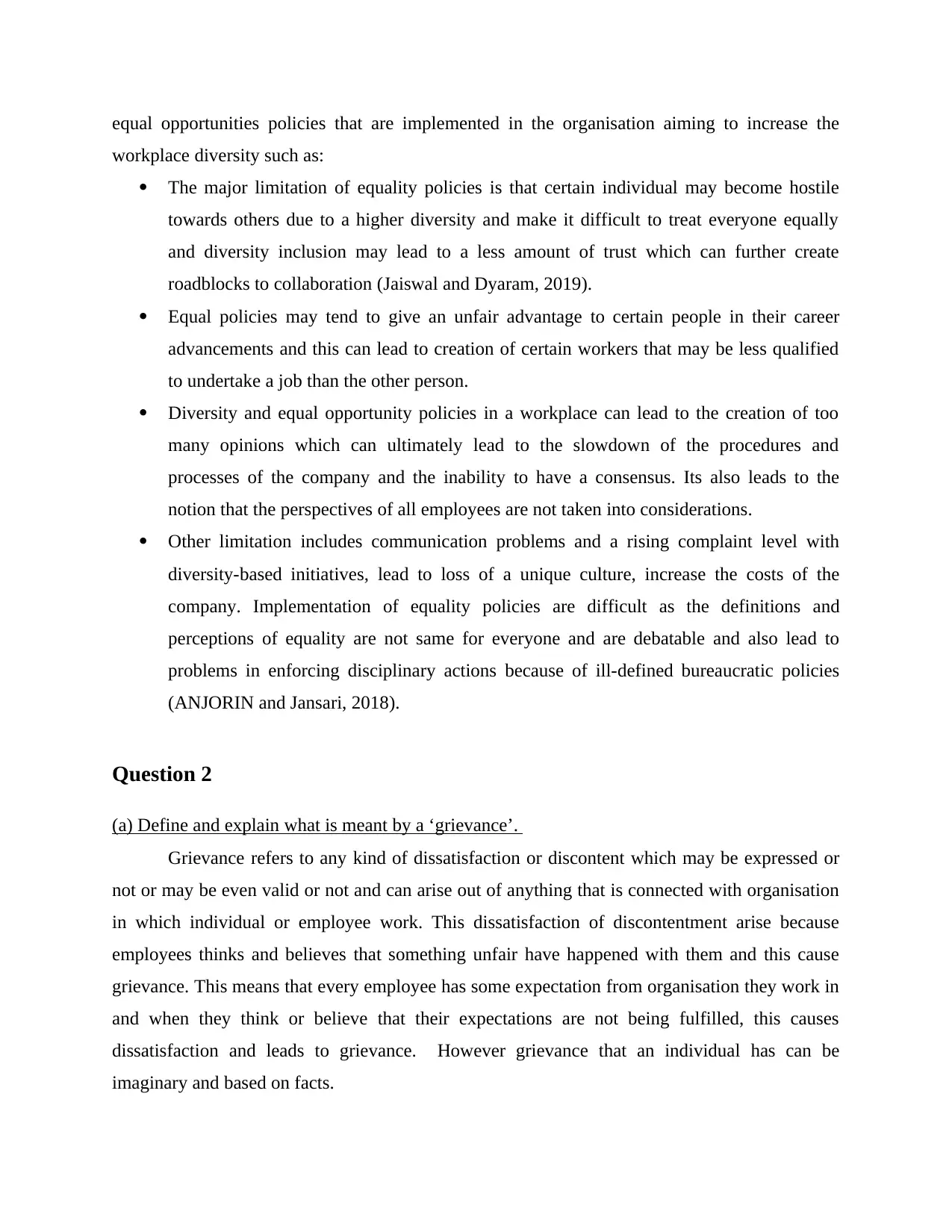
equal opportunities policies that are implemented in the organisation aiming to increase the
workplace diversity such as:
The major limitation of equality policies is that certain individual may become hostile
towards others due to a higher diversity and make it difficult to treat everyone equally
and diversity inclusion may lead to a less amount of trust which can further create
roadblocks to collaboration (Jaiswal and Dyaram, 2019).
Equal policies may tend to give an unfair advantage to certain people in their career
advancements and this can lead to creation of certain workers that may be less qualified
to undertake a job than the other person.
Diversity and equal opportunity policies in a workplace can lead to the creation of too
many opinions which can ultimately lead to the slowdown of the procedures and
processes of the company and the inability to have a consensus. Its also leads to the
notion that the perspectives of all employees are not taken into considerations.
Other limitation includes communication problems and a rising complaint level with
diversity-based initiatives, lead to loss of a unique culture, increase the costs of the
company. Implementation of equality policies are difficult as the definitions and
perceptions of equality are not same for everyone and are debatable and also lead to
problems in enforcing disciplinary actions because of ill-defined bureaucratic policies
(ANJORIN and Jansari, 2018).
Question 2
(a) Define and explain what is meant by a ‘grievance’.
Grievance refers to any kind of dissatisfaction or discontent which may be expressed or
not or may be even valid or not and can arise out of anything that is connected with organisation
in which individual or employee work. This dissatisfaction of discontentment arise because
employees thinks and believes that something unfair have happened with them and this cause
grievance. This means that every employee has some expectation from organisation they work in
and when they think or believe that their expectations are not being fulfilled, this causes
dissatisfaction and leads to grievance. However grievance that an individual has can be
imaginary and based on facts.
workplace diversity such as:
The major limitation of equality policies is that certain individual may become hostile
towards others due to a higher diversity and make it difficult to treat everyone equally
and diversity inclusion may lead to a less amount of trust which can further create
roadblocks to collaboration (Jaiswal and Dyaram, 2019).
Equal policies may tend to give an unfair advantage to certain people in their career
advancements and this can lead to creation of certain workers that may be less qualified
to undertake a job than the other person.
Diversity and equal opportunity policies in a workplace can lead to the creation of too
many opinions which can ultimately lead to the slowdown of the procedures and
processes of the company and the inability to have a consensus. Its also leads to the
notion that the perspectives of all employees are not taken into considerations.
Other limitation includes communication problems and a rising complaint level with
diversity-based initiatives, lead to loss of a unique culture, increase the costs of the
company. Implementation of equality policies are difficult as the definitions and
perceptions of equality are not same for everyone and are debatable and also lead to
problems in enforcing disciplinary actions because of ill-defined bureaucratic policies
(ANJORIN and Jansari, 2018).
Question 2
(a) Define and explain what is meant by a ‘grievance’.
Grievance refers to any kind of dissatisfaction or discontent which may be expressed or
not or may be even valid or not and can arise out of anything that is connected with organisation
in which individual or employee work. This dissatisfaction of discontentment arise because
employees thinks and believes that something unfair have happened with them and this cause
grievance. This means that every employee has some expectation from organisation they work in
and when they think or believe that their expectations are not being fulfilled, this causes
dissatisfaction and leads to grievance. However grievance that an individual has can be
imaginary and based on facts.
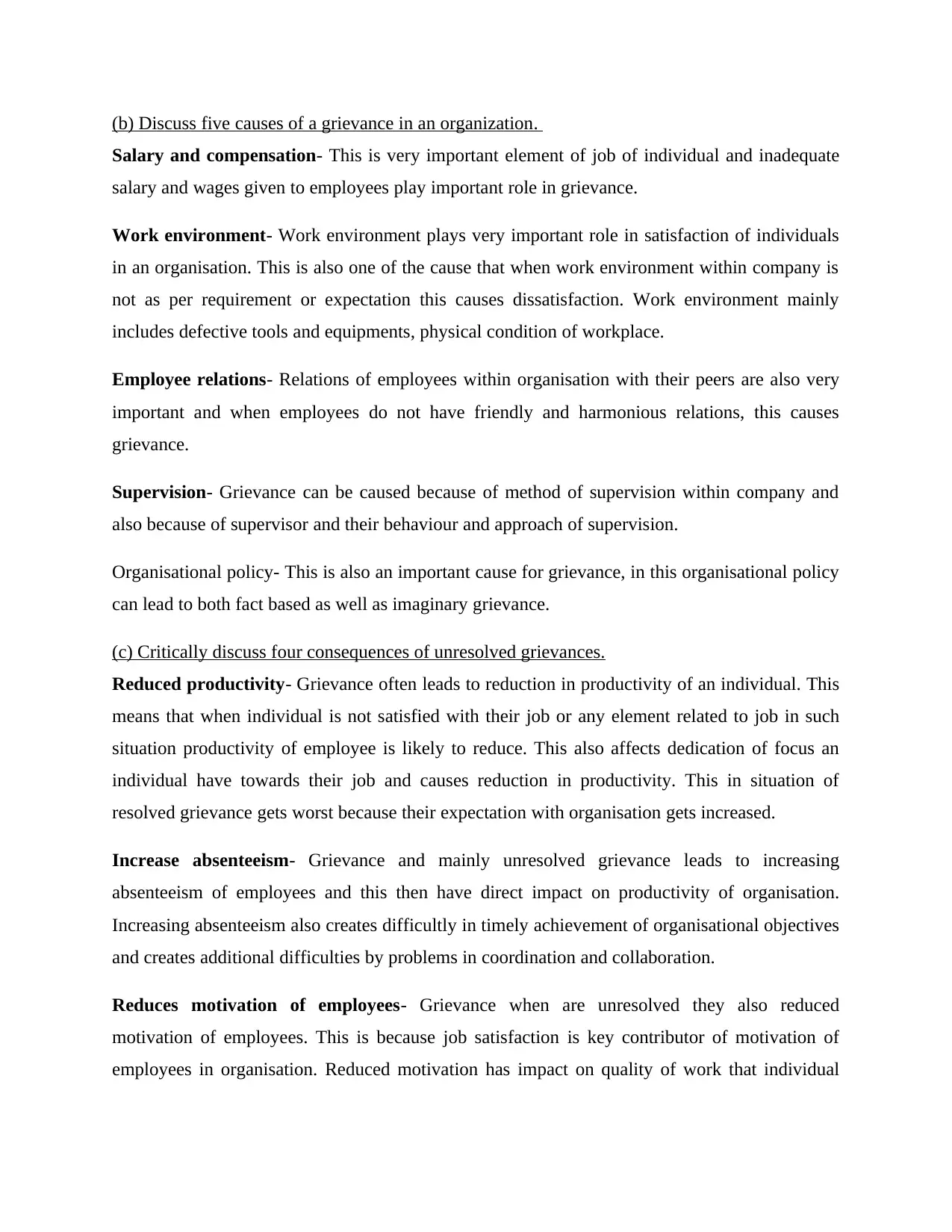
(b) Discuss five causes of a grievance in an organization.
Salary and compensation- This is very important element of job of individual and inadequate
salary and wages given to employees play important role in grievance.
Work environment- Work environment plays very important role in satisfaction of individuals
in an organisation. This is also one of the cause that when work environment within company is
not as per requirement or expectation this causes dissatisfaction. Work environment mainly
includes defective tools and equipments, physical condition of workplace.
Employee relations- Relations of employees within organisation with their peers are also very
important and when employees do not have friendly and harmonious relations, this causes
grievance.
Supervision- Grievance can be caused because of method of supervision within company and
also because of supervisor and their behaviour and approach of supervision.
Organisational policy- This is also an important cause for grievance, in this organisational policy
can lead to both fact based as well as imaginary grievance.
(c) Critically discuss four consequences of unresolved grievances.
Reduced productivity- Grievance often leads to reduction in productivity of an individual. This
means that when individual is not satisfied with their job or any element related to job in such
situation productivity of employee is likely to reduce. This also affects dedication of focus an
individual have towards their job and causes reduction in productivity. This in situation of
resolved grievance gets worst because their expectation with organisation gets increased.
Increase absenteeism- Grievance and mainly unresolved grievance leads to increasing
absenteeism of employees and this then have direct impact on productivity of organisation.
Increasing absenteeism also creates difficultly in timely achievement of organisational objectives
and creates additional difficulties by problems in coordination and collaboration.
Reduces motivation of employees- Grievance when are unresolved they also reduced
motivation of employees. This is because job satisfaction is key contributor of motivation of
employees in organisation. Reduced motivation has impact on quality of work that individual
Salary and compensation- This is very important element of job of individual and inadequate
salary and wages given to employees play important role in grievance.
Work environment- Work environment plays very important role in satisfaction of individuals
in an organisation. This is also one of the cause that when work environment within company is
not as per requirement or expectation this causes dissatisfaction. Work environment mainly
includes defective tools and equipments, physical condition of workplace.
Employee relations- Relations of employees within organisation with their peers are also very
important and when employees do not have friendly and harmonious relations, this causes
grievance.
Supervision- Grievance can be caused because of method of supervision within company and
also because of supervisor and their behaviour and approach of supervision.
Organisational policy- This is also an important cause for grievance, in this organisational policy
can lead to both fact based as well as imaginary grievance.
(c) Critically discuss four consequences of unresolved grievances.
Reduced productivity- Grievance often leads to reduction in productivity of an individual. This
means that when individual is not satisfied with their job or any element related to job in such
situation productivity of employee is likely to reduce. This also affects dedication of focus an
individual have towards their job and causes reduction in productivity. This in situation of
resolved grievance gets worst because their expectation with organisation gets increased.
Increase absenteeism- Grievance and mainly unresolved grievance leads to increasing
absenteeism of employees and this then have direct impact on productivity of organisation.
Increasing absenteeism also creates difficultly in timely achievement of organisational objectives
and creates additional difficulties by problems in coordination and collaboration.
Reduces motivation of employees- Grievance when are unresolved they also reduced
motivation of employees. This is because job satisfaction is key contributor of motivation of
employees in organisation. Reduced motivation has impact on quality of work that individual
⊘ This is a preview!⊘
Do you want full access?
Subscribe today to unlock all pages.

Trusted by 1+ million students worldwide
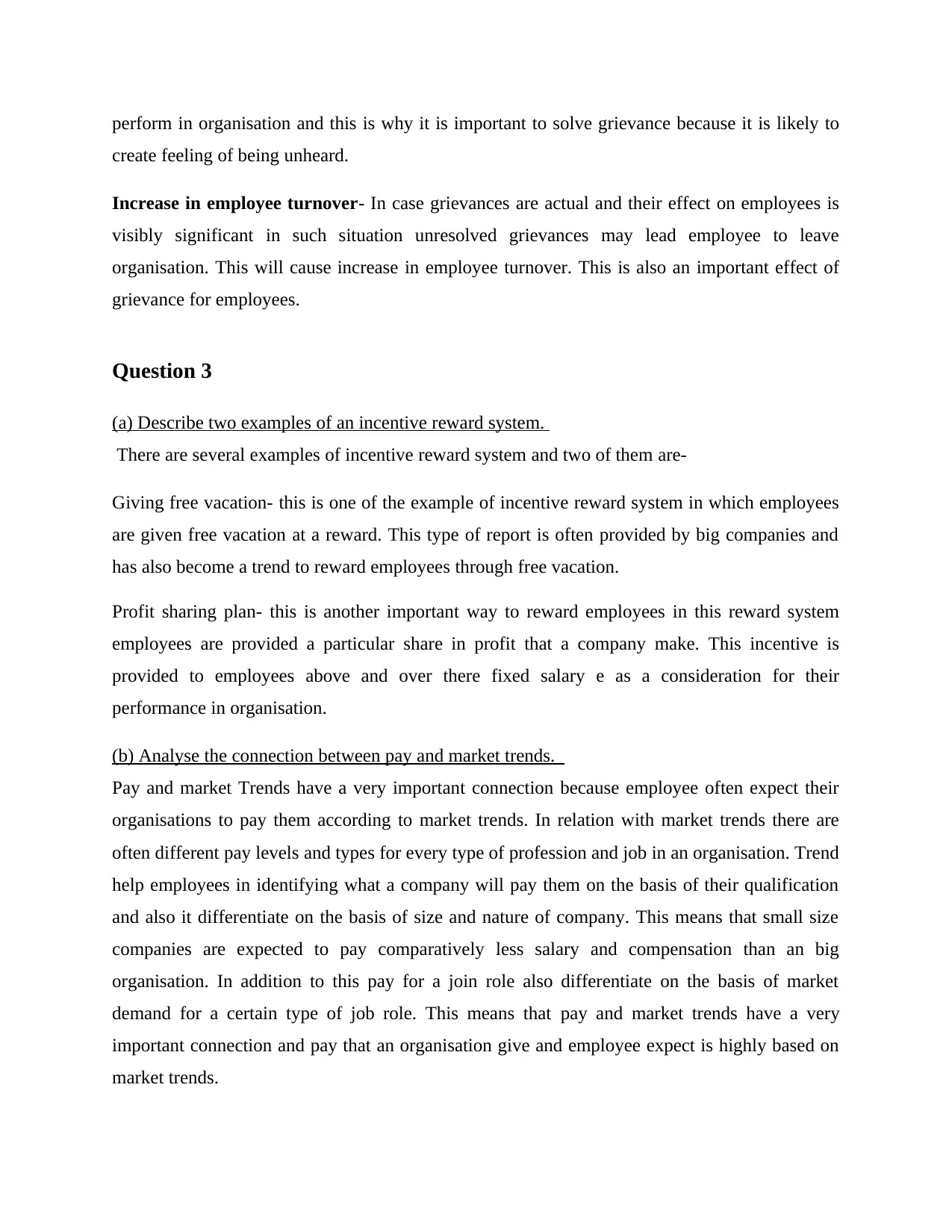
perform in organisation and this is why it is important to solve grievance because it is likely to
create feeling of being unheard.
Increase in employee turnover- In case grievances are actual and their effect on employees is
visibly significant in such situation unresolved grievances may lead employee to leave
organisation. This will cause increase in employee turnover. This is also an important effect of
grievance for employees.
Question 3
(a) Describe two examples of an incentive reward system.
There are several examples of incentive reward system and two of them are-
Giving free vacation- this is one of the example of incentive reward system in which employees
are given free vacation at a reward. This type of report is often provided by big companies and
has also become a trend to reward employees through free vacation.
Profit sharing plan- this is another important way to reward employees in this reward system
employees are provided a particular share in profit that a company make. This incentive is
provided to employees above and over there fixed salary e as a consideration for their
performance in organisation.
(b) Analyse the connection between pay and market trends.
Pay and market Trends have a very important connection because employee often expect their
organisations to pay them according to market trends. In relation with market trends there are
often different pay levels and types for every type of profession and job in an organisation. Trend
help employees in identifying what a company will pay them on the basis of their qualification
and also it differentiate on the basis of size and nature of company. This means that small size
companies are expected to pay comparatively less salary and compensation than an big
organisation. In addition to this pay for a join role also differentiate on the basis of market
demand for a certain type of job role. This means that pay and market trends have a very
important connection and pay that an organisation give and employee expect is highly based on
market trends.
create feeling of being unheard.
Increase in employee turnover- In case grievances are actual and their effect on employees is
visibly significant in such situation unresolved grievances may lead employee to leave
organisation. This will cause increase in employee turnover. This is also an important effect of
grievance for employees.
Question 3
(a) Describe two examples of an incentive reward system.
There are several examples of incentive reward system and two of them are-
Giving free vacation- this is one of the example of incentive reward system in which employees
are given free vacation at a reward. This type of report is often provided by big companies and
has also become a trend to reward employees through free vacation.
Profit sharing plan- this is another important way to reward employees in this reward system
employees are provided a particular share in profit that a company make. This incentive is
provided to employees above and over there fixed salary e as a consideration for their
performance in organisation.
(b) Analyse the connection between pay and market trends.
Pay and market Trends have a very important connection because employee often expect their
organisations to pay them according to market trends. In relation with market trends there are
often different pay levels and types for every type of profession and job in an organisation. Trend
help employees in identifying what a company will pay them on the basis of their qualification
and also it differentiate on the basis of size and nature of company. This means that small size
companies are expected to pay comparatively less salary and compensation than an big
organisation. In addition to this pay for a join role also differentiate on the basis of market
demand for a certain type of job role. This means that pay and market trends have a very
important connection and pay that an organisation give and employee expect is highly based on
market trends.
Paraphrase This Document
Need a fresh take? Get an instant paraphrase of this document with our AI Paraphraser
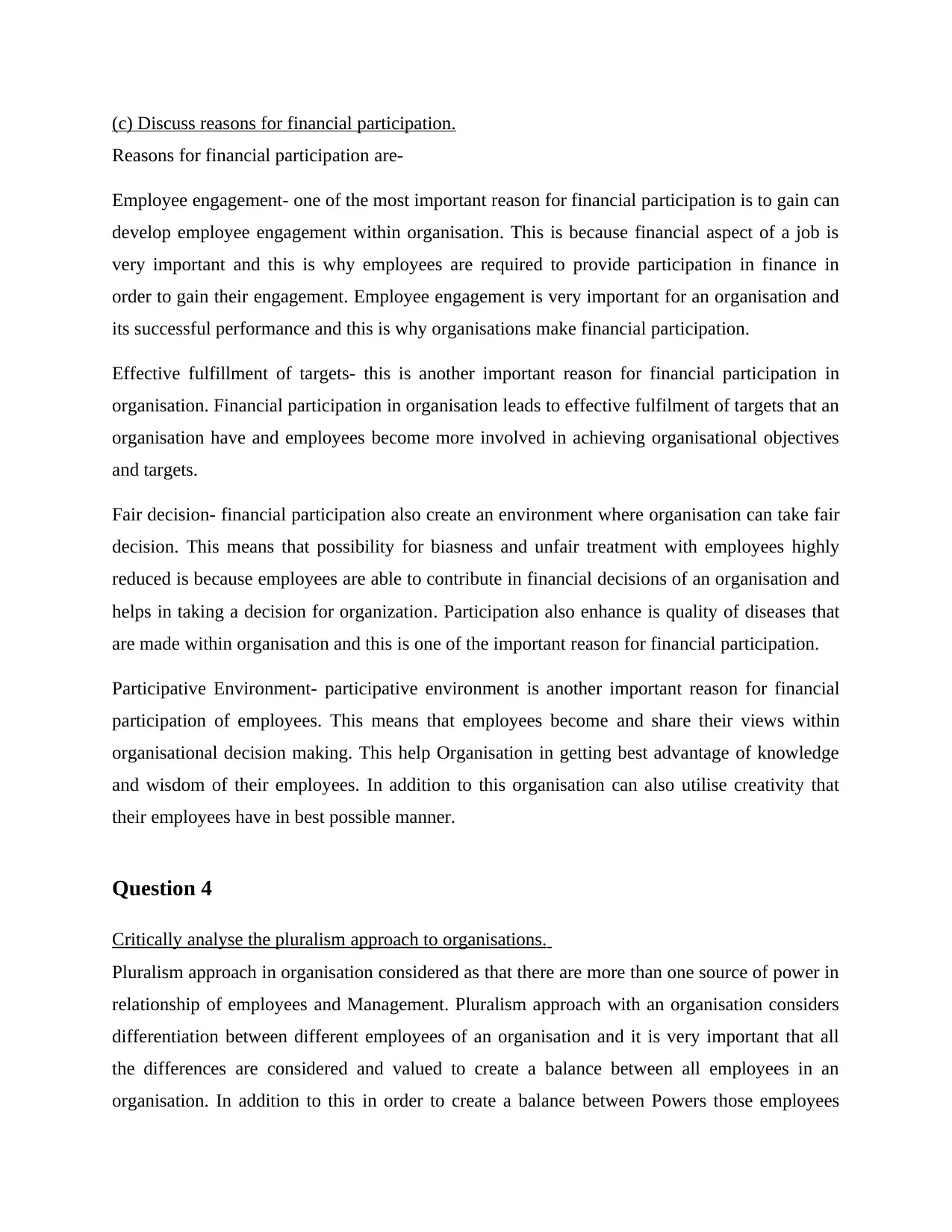
(c) Discuss reasons for financial participation.
Reasons for financial participation are-
Employee engagement- one of the most important reason for financial participation is to gain can
develop employee engagement within organisation. This is because financial aspect of a job is
very important and this is why employees are required to provide participation in finance in
order to gain their engagement. Employee engagement is very important for an organisation and
its successful performance and this is why organisations make financial participation.
Effective fulfillment of targets- this is another important reason for financial participation in
organisation. Financial participation in organisation leads to effective fulfilment of targets that an
organisation have and employees become more involved in achieving organisational objectives
and targets.
Fair decision- financial participation also create an environment where organisation can take fair
decision. This means that possibility for biasness and unfair treatment with employees highly
reduced is because employees are able to contribute in financial decisions of an organisation and
helps in taking a decision for organization. Participation also enhance is quality of diseases that
are made within organisation and this is one of the important reason for financial participation.
Participative Environment- participative environment is another important reason for financial
participation of employees. This means that employees become and share their views within
organisational decision making. This help Organisation in getting best advantage of knowledge
and wisdom of their employees. In addition to this organisation can also utilise creativity that
their employees have in best possible manner.
Question 4
Critically analyse the pluralism approach to organisations.
Pluralism approach in organisation considered as that there are more than one source of power in
relationship of employees and Management. Pluralism approach with an organisation considers
differentiation between different employees of an organisation and it is very important that all
the differences are considered and valued to create a balance between all employees in an
organisation. In addition to this in order to create a balance between Powers those employees
Reasons for financial participation are-
Employee engagement- one of the most important reason for financial participation is to gain can
develop employee engagement within organisation. This is because financial aspect of a job is
very important and this is why employees are required to provide participation in finance in
order to gain their engagement. Employee engagement is very important for an organisation and
its successful performance and this is why organisations make financial participation.
Effective fulfillment of targets- this is another important reason for financial participation in
organisation. Financial participation in organisation leads to effective fulfilment of targets that an
organisation have and employees become more involved in achieving organisational objectives
and targets.
Fair decision- financial participation also create an environment where organisation can take fair
decision. This means that possibility for biasness and unfair treatment with employees highly
reduced is because employees are able to contribute in financial decisions of an organisation and
helps in taking a decision for organization. Participation also enhance is quality of diseases that
are made within organisation and this is one of the important reason for financial participation.
Participative Environment- participative environment is another important reason for financial
participation of employees. This means that employees become and share their views within
organisational decision making. This help Organisation in getting best advantage of knowledge
and wisdom of their employees. In addition to this organisation can also utilise creativity that
their employees have in best possible manner.
Question 4
Critically analyse the pluralism approach to organisations.
Pluralism approach in organisation considered as that there are more than one source of power in
relationship of employees and Management. Pluralism approach with an organisation considers
differentiation between different employees of an organisation and it is very important that all
the differences are considered and valued to create a balance between all employees in an
organisation. In addition to this in order to create a balance between Powers those employees
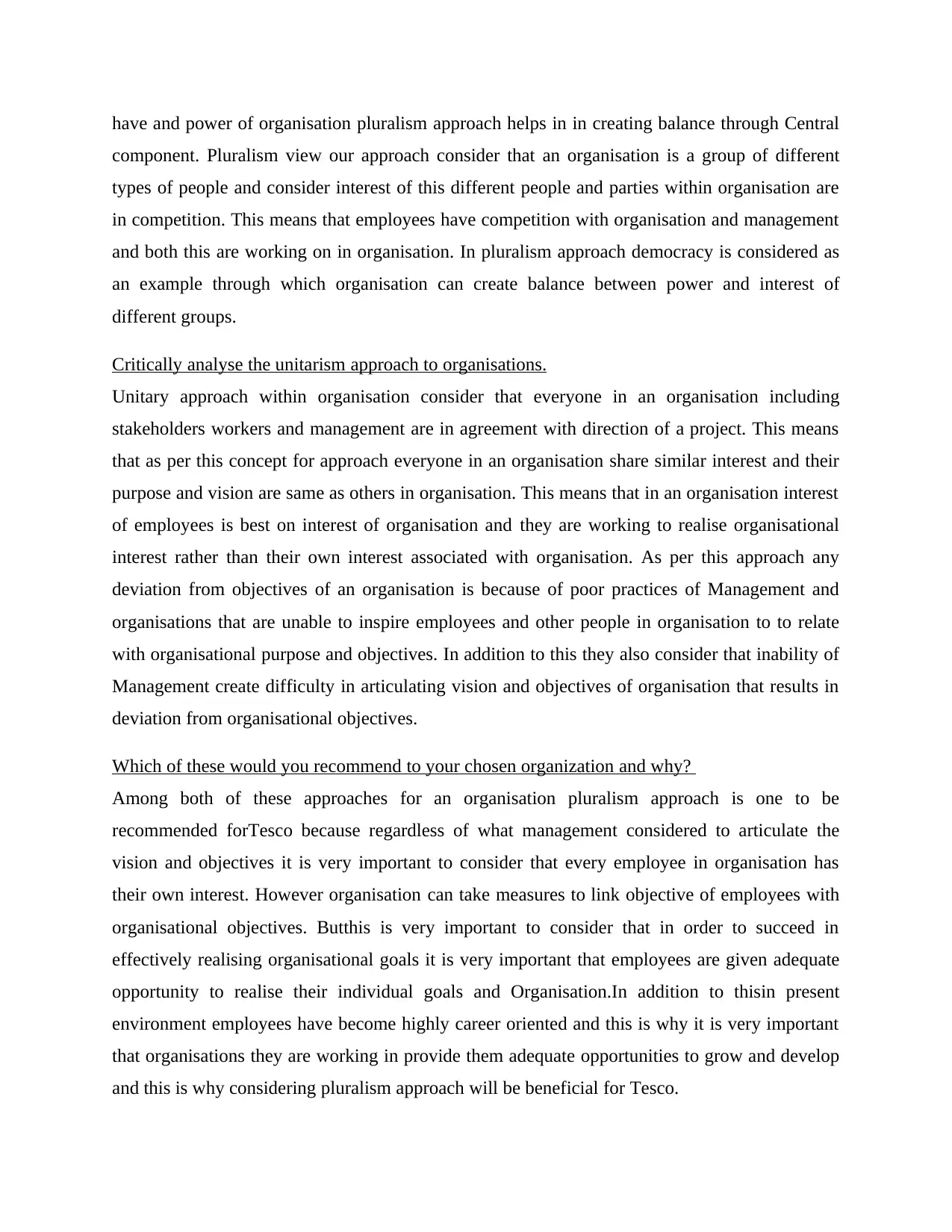
have and power of organisation pluralism approach helps in in creating balance through Central
component. Pluralism view our approach consider that an organisation is a group of different
types of people and consider interest of this different people and parties within organisation are
in competition. This means that employees have competition with organisation and management
and both this are working on in organisation. In pluralism approach democracy is considered as
an example through which organisation can create balance between power and interest of
different groups.
Critically analyse the unitarism approach to organisations.
Unitary approach within organisation consider that everyone in an organisation including
stakeholders workers and management are in agreement with direction of a project. This means
that as per this concept for approach everyone in an organisation share similar interest and their
purpose and vision are same as others in organisation. This means that in an organisation interest
of employees is best on interest of organisation and they are working to realise organisational
interest rather than their own interest associated with organisation. As per this approach any
deviation from objectives of an organisation is because of poor practices of Management and
organisations that are unable to inspire employees and other people in organisation to to relate
with organisational purpose and objectives. In addition to this they also consider that inability of
Management create difficulty in articulating vision and objectives of organisation that results in
deviation from organisational objectives.
Which of these would you recommend to your chosen organization and why?
Among both of these approaches for an organisation pluralism approach is one to be
recommended forTesco because regardless of what management considered to articulate the
vision and objectives it is very important to consider that every employee in organisation has
their own interest. However organisation can take measures to link objective of employees with
organisational objectives. Butthis is very important to consider that in order to succeed in
effectively realising organisational goals it is very important that employees are given adequate
opportunity to realise their individual goals and Organisation.In addition to thisin present
environment employees have become highly career oriented and this is why it is very important
that organisations they are working in provide them adequate opportunities to grow and develop
and this is why considering pluralism approach will be beneficial for Tesco.
component. Pluralism view our approach consider that an organisation is a group of different
types of people and consider interest of this different people and parties within organisation are
in competition. This means that employees have competition with organisation and management
and both this are working on in organisation. In pluralism approach democracy is considered as
an example through which organisation can create balance between power and interest of
different groups.
Critically analyse the unitarism approach to organisations.
Unitary approach within organisation consider that everyone in an organisation including
stakeholders workers and management are in agreement with direction of a project. This means
that as per this concept for approach everyone in an organisation share similar interest and their
purpose and vision are same as others in organisation. This means that in an organisation interest
of employees is best on interest of organisation and they are working to realise organisational
interest rather than their own interest associated with organisation. As per this approach any
deviation from objectives of an organisation is because of poor practices of Management and
organisations that are unable to inspire employees and other people in organisation to to relate
with organisational purpose and objectives. In addition to this they also consider that inability of
Management create difficulty in articulating vision and objectives of organisation that results in
deviation from organisational objectives.
Which of these would you recommend to your chosen organization and why?
Among both of these approaches for an organisation pluralism approach is one to be
recommended forTesco because regardless of what management considered to articulate the
vision and objectives it is very important to consider that every employee in organisation has
their own interest. However organisation can take measures to link objective of employees with
organisational objectives. Butthis is very important to consider that in order to succeed in
effectively realising organisational goals it is very important that employees are given adequate
opportunity to realise their individual goals and Organisation.In addition to thisin present
environment employees have become highly career oriented and this is why it is very important
that organisations they are working in provide them adequate opportunities to grow and develop
and this is why considering pluralism approach will be beneficial for Tesco.
⊘ This is a preview!⊘
Do you want full access?
Subscribe today to unlock all pages.

Trusted by 1+ million students worldwide

Paraphrase This Document
Need a fresh take? Get an instant paraphrase of this document with our AI Paraphraser
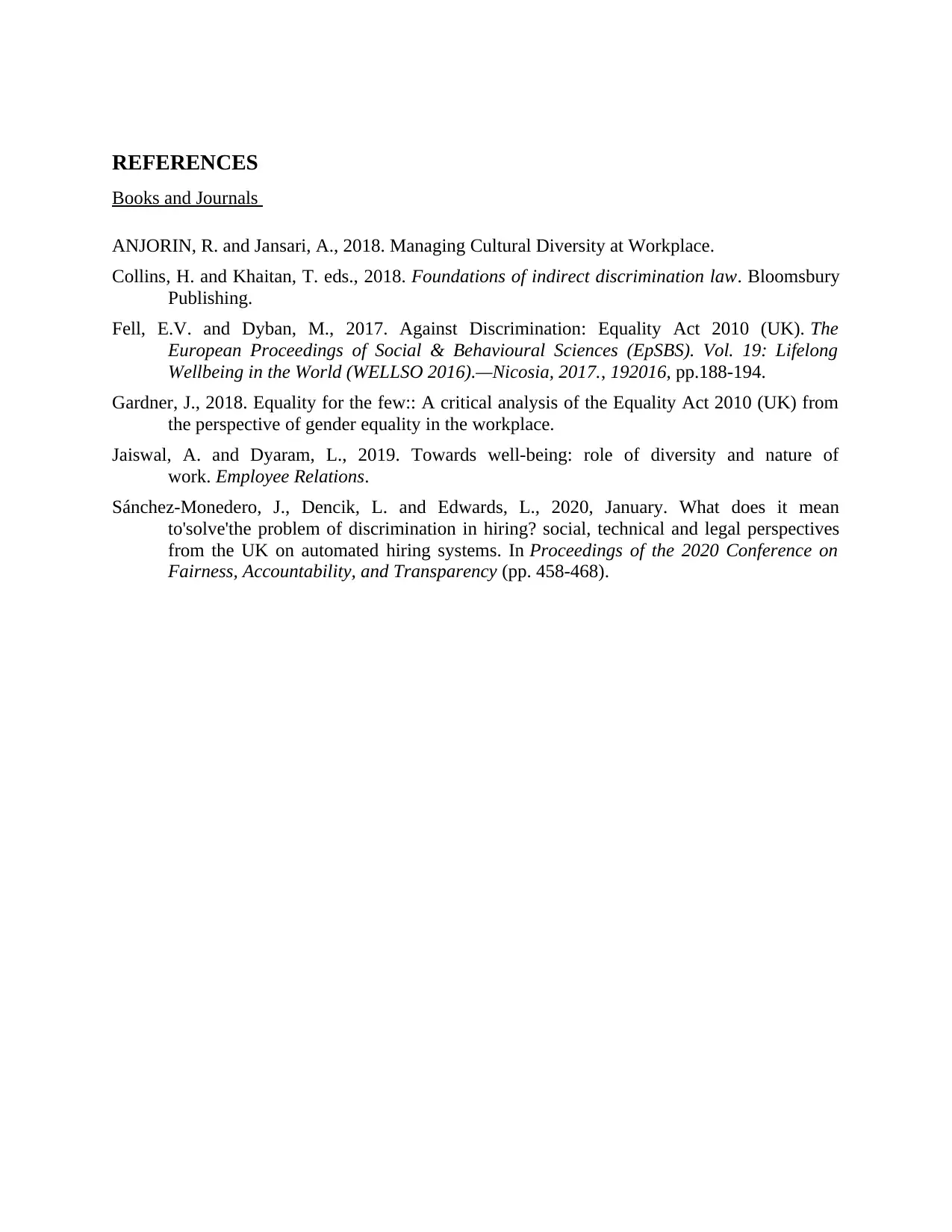
REFERENCES
Books and Journals
ANJORIN, R. and Jansari, A., 2018. Managing Cultural Diversity at Workplace.
Collins, H. and Khaitan, T. eds., 2018. Foundations of indirect discrimination law. Bloomsbury
Publishing.
Fell, E.V. and Dyban, M., 2017. Against Discrimination: Equality Act 2010 (UK). The
European Proceedings of Social & Behavioural Sciences (EpSBS). Vol. 19: Lifelong
Wellbeing in the World (WELLSO 2016).—Nicosia, 2017., 192016, pp.188-194.
Gardner, J., 2018. Equality for the few:: A critical analysis of the Equality Act 2010 (UK) from
the perspective of gender equality in the workplace.
Jaiswal, A. and Dyaram, L., 2019. Towards well-being: role of diversity and nature of
work. Employee Relations.
Sánchez-Monedero, J., Dencik, L. and Edwards, L., 2020, January. What does it mean
to'solve'the problem of discrimination in hiring? social, technical and legal perspectives
from the UK on automated hiring systems. In Proceedings of the 2020 Conference on
Fairness, Accountability, and Transparency (pp. 458-468).
Books and Journals
ANJORIN, R. and Jansari, A., 2018. Managing Cultural Diversity at Workplace.
Collins, H. and Khaitan, T. eds., 2018. Foundations of indirect discrimination law. Bloomsbury
Publishing.
Fell, E.V. and Dyban, M., 2017. Against Discrimination: Equality Act 2010 (UK). The
European Proceedings of Social & Behavioural Sciences (EpSBS). Vol. 19: Lifelong
Wellbeing in the World (WELLSO 2016).—Nicosia, 2017., 192016, pp.188-194.
Gardner, J., 2018. Equality for the few:: A critical analysis of the Equality Act 2010 (UK) from
the perspective of gender equality in the workplace.
Jaiswal, A. and Dyaram, L., 2019. Towards well-being: role of diversity and nature of
work. Employee Relations.
Sánchez-Monedero, J., Dencik, L. and Edwards, L., 2020, January. What does it mean
to'solve'the problem of discrimination in hiring? social, technical and legal perspectives
from the UK on automated hiring systems. In Proceedings of the 2020 Conference on
Fairness, Accountability, and Transparency (pp. 458-468).
1 out of 11
Related Documents
Your All-in-One AI-Powered Toolkit for Academic Success.
+13062052269
info@desklib.com
Available 24*7 on WhatsApp / Email
![[object Object]](/_next/static/media/star-bottom.7253800d.svg)
Unlock your academic potential
Copyright © 2020–2025 A2Z Services. All Rights Reserved. Developed and managed by ZUCOL.





